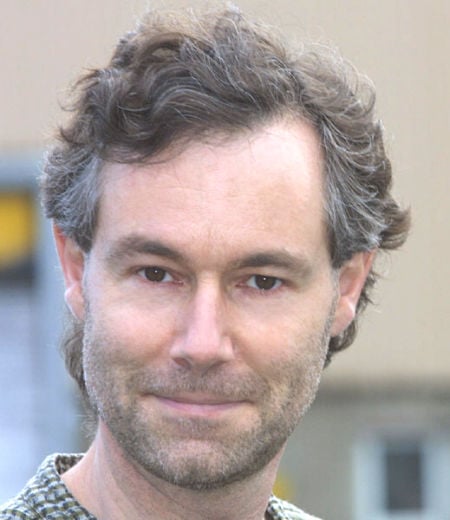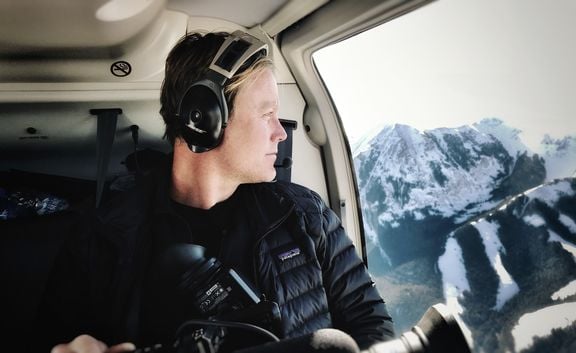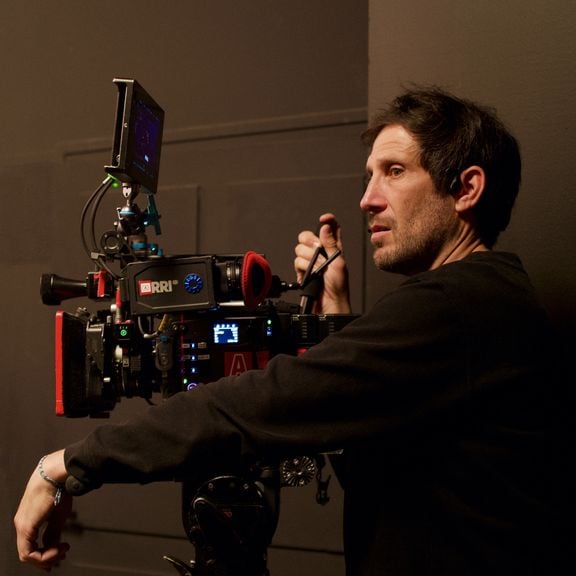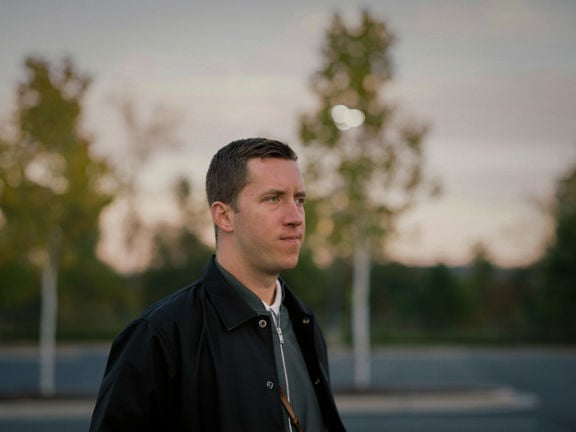GAVIN FINNEY, BSC BRINGS LEITZ SUMMILUX-C BACK TO WOLF HALL: THE MIRROR AND THE LIGHT
Wolf Hall: The Mirror and The Light is a BBC dramatic series continuing the story of the 2015 Wolf Hall limited series. The story is based on a trilogy of novels from Hilary Mantel and follows the rise and fall of Thomas Cromwell in 16th century England. The award-winning series stars Mark Rylance as Cromwell and is directed by Peter Kosminsky.
Seth Emmons: It’s been nine years since we were last in the world of Wolf Hall. What can you tell us about season 2?
Gavin Finney, BSC: The entire series is based on the books by Hilary Mantle. Season 1 covers the first two books and the new season covers the events of the last book, “The Mirror and the Light.” Season 2 picks up almost immediately from season 1, which ends with the execution of Anne Boleyn and the rise of Thomas Cromwell. Henry marries Jane Seymour and Cromwell struggles to hold onto his power as outside forces mount up against him.
Thomas Cromwell’s story is incredible because he was a blacksmith’s boy, the lowest of the low in English society, and rose to be the most powerful man in England next to the king. At that time such a rise in station did not happen. If you weren’t born into either the aristocracy or the clergy you didn’t really have a chance.
That same social rigidity led to his downfall. The Dukes of Norfolk and Suffolk and the bishops of the church started ganging up on him because they didn’t like the power he had or how he wielded it. He oversaw the dissolution of the monasteries, places of power for hundreds of years, by shutting them down and taking all their wealth, power and land. He made a lot of enemies. Season 2 tells the story of what happened to him. I would suggest watching season 1 first, but you don’t need to know the full history to enjoy the series. In fact, a little naivete makes the story more exciting.
Ten years between shooting season 1 and 2 is a big jump. Were you able to bring back any of the same crews from the first season?
We actually had a lot of the same crew, especially in camera, although some people changed positions. My genius focus puller on season 1, Christopher Reynolds, has moved up to become a great operator and operated the B camera. My A camera focus puller was Joanne Smith, who was a loader for me 10 years ago on another show. Clare Connor was clapper loader and Laura Booth was a trainee on season 1 and they shared B camera focus puller duties on season 2. We had an all-female focus crew and an all-female grip crew.
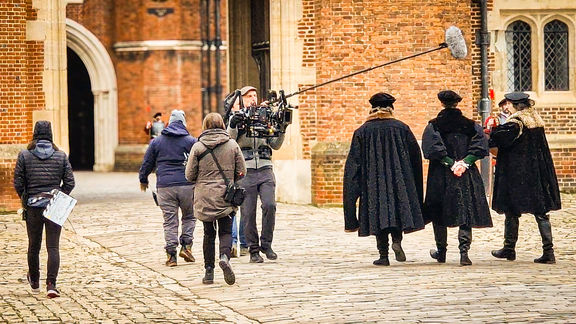
How did it work having two focus pullers for one camera?
A few years ago I had a conversation with some female focus pullers who proposed a job share scheme that would allow two people to share the position so they could have a few days off each week to manage the family. Five days away from home is hard, especially on a 16-week shoot like this one. But 2 ½ or 3 days is much easier. Then you have 4 days at home each week.
Clare has two young children and for this season we were able to get the production to pay for half a week each for Clare and Laura plus a crossover day via a fund provided by Screenskills. It worked really well.
If we want more women in the film industry we have to help them have families if that’s what they want. Traditionally, if a woman in our industry wanted a family she would have to stay home and opt out of the business for years and likely lose her place and any momentum in her career. That’s really not acceptable, so we have to find a way to accommodate that. I like having a gender balanced and diverse crew because that’s what my high street looks like and I think that’s what a crew should look like, especially when there are so many excellent crew from all walks of life who want to work in the industry.
Before starting season 2 were there any things that you and director Peter Kosminsky talked about changing?
I’ve done a lot of multiple season shows, most recently Good Omens, and each time you start a new season you’re up against two things. One, if you’re doing another season it’s because the previous season was successful, so how much do you really want to change it? That’s one way of looking at it. But, at the same time you want to evolve and explore new opportunities.
In actuality, we didn’t change very much. I’ve worked with Peter on four different projects so we know pretty well what we’re doing and what works. However, just like on every job, I started from scratch in terms of camera and lenses.
We shot the first season on ARRI Alexa SXT cameras with Leitz SUMMILUX-C lenses, but a lot has happened in 10 years. I looked at large format cameras, large format glass, old glass, rehoused old glass, and the very newest glass. There’s a forest of lenses out there right now. Graham Hawkins at 24-7 Drama did a great job of getting us everything we wanted to test.
There were some parameters that allowed us to narrow things down quickly. We primarily shoot handheld and that eliminated some larger camera bodies and larger lenses. Low light performance has always been the most important thing for this show. How does it look with candlelight, fireplaces, etc.? We tried so many new combinations of cameras and lenses, but nothing matched the Leitz SUMMILUX-C lenses in terms of their control of light.
You normally see weird things at 3200 ASA with one candle in the frame. Weird flares, weird ghosting, weird things with focus, but the Leitz lenses cope with it unlike any other lenses. They just work. Their speed is incredible and the contrast remains at T1.4 instead of going soft like some lenses do wide open. They have zero focus breathing and zero chromatic aberration, which is really important for me. I find CA kind of ugly. For Wolf Hall we’ll have hundreds of candles and firelight everywhere. CA is a real pain to get rid of in post. You see it a lot now because people are using so much vintage glass, but I find it to be a bit of a distraction.
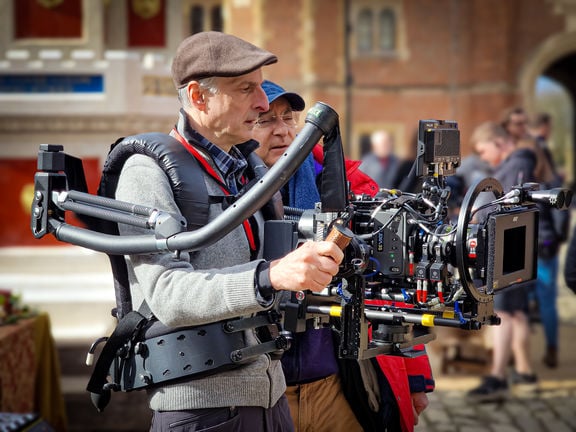
What about cameras?
I also tested all the current cameras from RED, Sony and ARRI with an open mind, but the Alexa 35 was just brilliant. The original sensor in the Alexa SXT was very, very good when it came out, but it did have certain colour anachronisms. It would over-punch green, and very strong reds would sometimes shift to purple. At very, very low light levels flames would just white out. To be fair there was no camera at the time, not even film, that could cope with our show’s dynamic range differences.
The Alexa 35 has an extraordinary highlight range. The stated 17 stops is correct. We were lighting almost completely through windows, old and dirty windows that absorbed a lot of light and got very bright. On season 1 we were always struggling with windows clipping out, but it never happened with the Alexa 35. Candles hardly ever clipped out. Firelight didn’t clip out. We were able to pull all the detail back in during the grade. 6400 ASA in enhanced sensitivity range was no problem at all.
Did the lenses determine the format of Super 35, or was that decided by the camera/lens combination?
It was a co-decision. Shooting S35 at T1.4 is already very shallow focus. Add in that we were shooting handheld, sometimes at night or in very low light. We would use glow-in-the-dark tape that you charge with a torch just to not trip over things. There are usually no marks, neither for me as the operator nor for the actors. We’re all dancing together and stopping where we feel like and the focus pullers have to keep up. They did an amazing job, but shooting like this with a large format sensor would have been extremely tough.
I shot with the Alexa LF on Good Omens season 2 and it was beautiful, but it wasn’t the right choice for this project. We’ve still got 6K resolution and the colours are great. The greens don’t pop and the reds stay where they are. There is so much depth in the colours.
Did you use any filtration in front of the lens?
Yes, we used quite a variety of filters. I used ¼ Tiffen Bronze Glimmerglass to give the royal palaces a bit of richness. For everywhere else I used Tiffen Black Diffusion FX because it’s a kind of invisible diffusion. It doesn’t halate very much or fog at all, but it helps with wig lace lines. We had a lot of hair pieces and beards. A bit of diffusion, especially with sharper lenses at high resolutions, takes the edge off and helps hair and make up.
I tested the new Tiffen Night Fogs, Black Fogs and Smoque. The Night Fogs and Black Fogs were really interesting. They mute the colours slightly and bring highlights down, but don’t give you the rainbow bloom around sources like Smoque filters do. Everyone uses atmosphere, especially in period work, but none of the curators of these old houses would let us so we had to do it with filters or embrace the cleaner look. For outside scenes the Night Fogs and sometimes Black Pro-Mist would give just a bit of something in the air.
In night scenes with candles I didn’t use any diffusion because the SUMMILUX-C lenses give a lovely little glow and that’s enough. The frame becomes a ball of fire if you add a filter at 1600 or 3200 ASA at T1.4 with 200 candles in the shot.
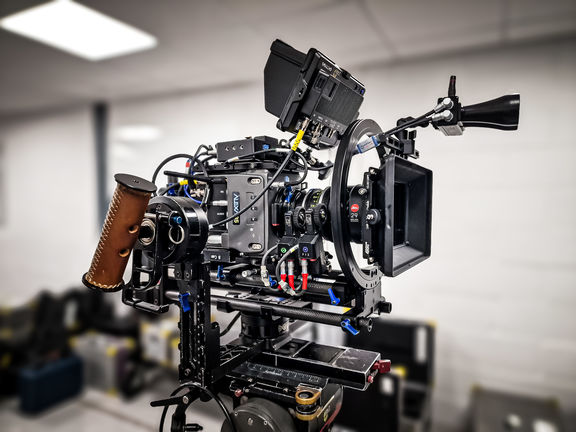
You’ve described the method you and Peter shoot as similar to a modern documentary. Can you unpack that?
The traditional trope for shooting historical drama and period fiction is to shoot on film, or add the film effect in post, and use vintage lenses, soft light, and lots of haze. It’s almost automatic for some productions. Lots of amber colours, beautiful costumes, prop candles. We approached the project as a documentary and asked ourselves, how would we shoot if it was present day?
Hilary Mantel said once that these people didn’t know they were in history or part of history. Horses were just transportation. They didn’t wear costumes, they wore clothes. These big buildings are where they happened to live. It wasn’t amazing to them. So we decided not to foreground any of that, not spend a lot of time looking at our big ballroom or sweep through the chandelier. To Thomas Cromwell it was just a building where he worked. Through their eyes the world around them wasn’t fluffy, soft or blurred. It was often bright, colourful, clean, sharp, real, so that’s how we shot it. It kicks against the usual way to shoot period.
The other thing that Peter does is almost always shoot the entire scene handheld in a single shot even if it starts outside, goes inside, passes through a hall, ends up in another rooms, sits at a table… There were some shots as long as 17 or 18 minutes with our amazing actors getting all their lines right. It will always be cut up, which kills me a little bit given the effort and inevitable compromise to the lighting, but the way Peter works with the actors and their performance is that he doesn’t break it down in the moment. He lets the scene flow from every angle we shoot so the actors are into it instead of breaking down the other angles to compliment the master shot.
How do you think that impacts the viewers’ experiences?
I don’t know, we’d have to ask the audience. [laughter] In a way, we don’t want the audience to think about what we’re doing. We want them to get drawn into the story. One thing that Peter does is he shoots everything from Cromwell’s POV so we never leave Cromwell’s side. If he’s not in the room, we’re not in the room. We only witness what he sees and from where he sees it. That does inform the look and the mise-en-scene very much throughout. If there’s a big feast, we’ll only see the feast from where he’s at. We won’t be flying through it or tracking around the other side of the table. I think that creates an intimacy with the lead character. He’s the energy. He’s the driver.
In the UK there is a reality TV series called Gogglebox which films regular people at home watching television. It’s very popular. The camera is mainly pointed right at the viewers from the position of the television. Often they’ll be talking or drinking or on their phone. For some reason they did one with Wolf Hall and at the end of the season you see people watching the execution of Anne Boleyn and throughout that sequence the viewers were glued to the screen. They didn’t look away, they didn’t speak. They were leaning in and were shocked when it happened. That’s the reaction of someone pulled so deeply into a story that they forget they’re watching a drama. I think our style can pull people into the story as if they’re watching reality because the acting is extraordinary and very real, very naturalistic.
What does your shooting process look like on set?
I’m operating the camera and Peter is either next to me or nearby in the same room with a small 7-inch monitor with auto-record and playback. There’s no video village. Peter’s style is very low impact, low footprint. Some other departments will have small, handheld monitors, but that’s it. Both Peter and I have worked in documentary, which is usually a tiny crew where the director is sometimes also the sound recordist working next to the cameraperson. The director is in the room and sees not just the person speaking, but more importantly the people not speaking. If you’re in a video village you’re only seeing what the camera is seeing.
We were often in a room with lots of actors at the same time. Peter can see through his little monitor what I’m seeing, but also everything else happening and direct me to another frame if something is developing or interesting.
Did you use any Steadicam or gimbal systems?
We didn’t use any on season 1 but we did more for this season, mostly where the ground was uneven or if the sequence needed a smoother look. For instance, there’s a dream-like fantasy sequence which we felt needed a different feel. When Cromwell was closing the monasteries he visited a lot of them and there was one called Launde Abbey he found particularly beautiful. His dream was that he would keep that property for himself and retire there. As things get more and more tense he begins to have dreams about Launde Abbey. For those, we shot on Steadicam and Letus Double Helix gimbal so we could be smooth throughout rather than having the handheld look.
Our normal handheld look was deliberately steady as well. We didn’t introduce any movement other than what our bodies are doing. It wasn’t about making it energetic or frenetic, but simply about being organic and reactive to the space and the actors so they could move where they wanted.
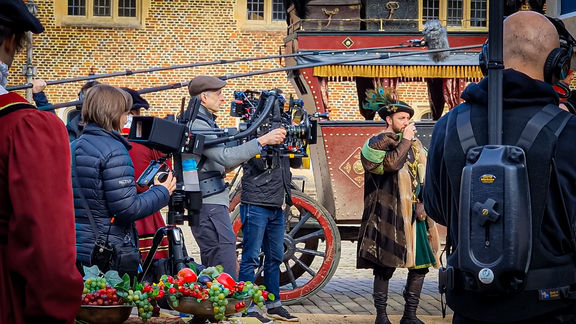
What about the gimbal system?
We used a gimbal called the Letus Double Helix. I’ve been using it since 2016. Rizwan Wadan runs the company Mr Helix Ltd. that provided it and has developed a lot of the IP in the system. It’s a very, very intuitive and robust gimbal that is strong enough to hold a film camera with a zoom lens. The motors are very powerful and there’s no wheels or joystick for control. You just steer intuitively; sort of like Steadicam is intuitive. If you want to pan you just move the handles the direction you want to point. If you want to tilt you move the right handle. It balances really quickly; lens changes take about 30 seconds.
I used a special rig to hold it called the Exhauss Exoskeleton. It’s from France and has two arms that come from the back and articulate around your body, which puts you at the fulcrum with half of the weight in front of you and the rest behind. The Z axis is totally neutral with no bounce. You can tune it and it can take up to 40 kilos. I was wearing about 27 kilos during Wolf Hall.
It actually compliments the Steadicam really well. I often used it as a compliment to the Steadicam, tracking alongside it. The Steadicam is quicker and more reactive at speed, but the Helix can do long, precise moves very well. It also booms up and down very easily and is nodal so you can point it straight at the ground or sky. These are all complementary tools.
Can you talk about some of your locations?
We were all over the Cotswolds around Bristol, Bath area, Wiltshire, Gloucestershire, Devon, mainly because there are a lot of Grade I listed buildings. There were so many incredible locations. It was like a grand tour of the great cathedrals, castles, and stately homes of England. We were constantly moving around, but it was great.
We used some new locations in season 2 but returned to some of the same ones from season 1. We went back to Great Chalfield, which stands in for Cromwell’s house Austin Friars. We revisited some of the cathedrals, Montecute house was another return. Some of the new ones were Hampton Court Palace, Haddon Hall in Derbyshire. Henry VIII visited many of them, as did Cromwell.
What were some of the challenges of working in practical historical locations?
Many. They are very precious and are well guarded by the curators. It takes a lot of negotiating to get people in, which is quite fair because they are unique properties. And the goalposts had shifted slightly since 2014 so it took more effort to persuade them to do things like light candles, which is key to the way we shoot. These buildings have been standing for 600 years with people lighting candles in them but all of the sudden this is a problem. Even if you’ve got a fire marshal and an extinguisher next to every candle it’s a problem. But you have to listen to them.
You can’t touch the fabrics. You can’t screw anything into anything. You can’t put any stress on the beams. You have to limit how powerful the lights are inside and outside, how far they are from windows or fabric, and how long they’re on. It’s all fair enough. Accidents are expensive and hard to repair, so you have to work within those constraints. We have a responsibility to be super respectful and organized so as to not mess it up for the next people to come in.
Being in these places has an effect on the performances as well. They have a sense of weight and history to them that you don’t get if you’re walking into a desolate warehouse in the middle of a factory outlet and onto a stage. The actors responded to it. Filming in Hampton Court, a place actually built by Thomas Wolsey and taken by Henry VIII, informs the performance immensely.
There’s also something special that happens with candlelight in these places. At Haddon Hall in Derbyshire the windows are all diamond-shaped leaded glass. They’re very wavy, not flat, and look like they’ve been blown in, but it’s a deliberate effect. The glaze refracts all the candlelight. When you stand in this huge 100-foot-long hall the windows all sparkle and refract like diamonds. It was a very expensive process for the craftspeople of the time. You’d never build that into a set, but when you put 200 candles in the actual location the effect is absolutely amazing. Combining these historical locations with our stripped-down style of shooting gave the actors so much freedom to embody these characters.
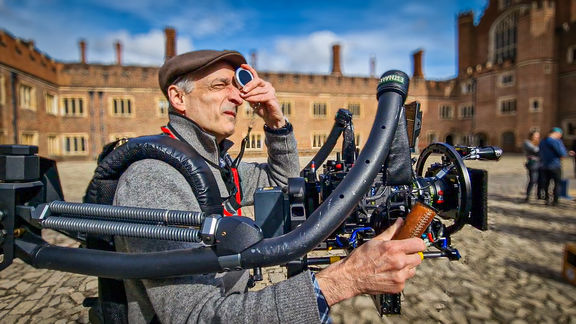

Overview
DoP Gavin Finney
